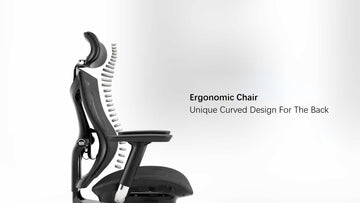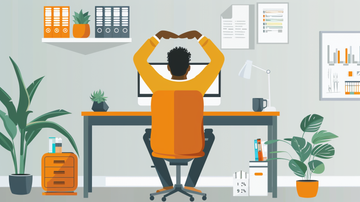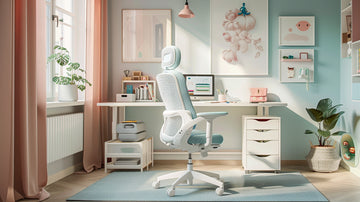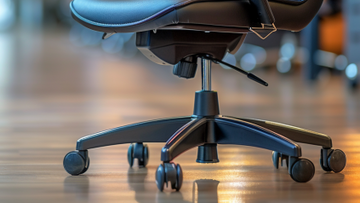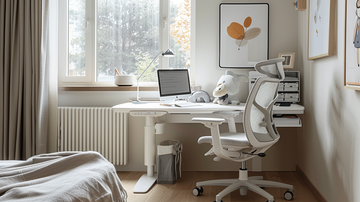Introduction
Having the right ergonomic office chair can be very important for people who have back problems and spend most of their day sitting at a desk. Although almost every ergonomic office chair says that it helps with back pain, this does not prove that the claim is valid in the real world. Investment in an ergonomic chair will help you avoid pain in the long run. It will also help you keep a healthy posture. This allows your spine to stay in a straight line. In addition, they have heights that can be changed so that you can keep your feet in a stable position without having to move your back.
What is an ergonomic chair?
Many people believe that ergonomic office chairs may be adjusted in height, depth, and back support. This is not the case at all. For this reason, you should be able to adapt both to the chair's height and the seat's depth to ensure that your legs are perpendicularly aligned with the floor. Your lower back should be supported enough to keep your spine in the correct position for proper posture. "Ergonomic" is not a sort of chair but rather a chair that provides greater support.
What kind of ergonomic chair should I use for back support?
A chair without a backrest, such as a yoga ball or a kneeling chair, can be purchased, as can one with a straight 90-degree backrest—this aids in maintaining a proper sitting posture. Your back pain may not be alleviated by exercises that improve posture and core strength. According to numerous studies, an ergonomic office chair with a reclining mechanism is recommended for persons who suffer from lower back pain. Study participants' spinal discs were examined to see how much pressure each sitting posture placed on them.
Is the height of the chair important when it comes to back support?
The height of an office chair's backrest and how it impacts back pain relief are not well researched, but it isn't easy to make sense of what you already know. Because a 135-degree reclined backrest is the most pleasant and supporting for back discomfort, it stands to reason that a high-back chair with a suitable headrest will be more supportive and comfortable when the backrest is at that angle. The neck and head are put under a lot of strain when we recline in a chair with a low back; thus, you don't want a chair with a low back for this reason.
Why should you choose an ergonomic chair for back support?
Ergonomic chairs are crucial for people who spend their days working in an office. Because they spend most of their time sitting at their desks, we'll explain why ergonomic chairs are crucial for back support, as well as why you should purchase one today.
Posture support:
If there is one thing you should be concerned about after sitting for a lengthy period, it is how you rise from your chair. Because these chairs do not have the proper back height, you may have observed that you lean forward when you sit in them. This is because the chairs don't have the correct back height. If you have a chair with a full-length design and support for a natural posture, you can be confident that it will assist you in improving your posture over time.
Increased Productivity:
According to some studies, choosing ergonomically built and comfortable office furniture can considerably impact the satisfaction and productivity of employees and the amount of work they perform at their employment.
Reduction in pain:
Back and neck discomfort are two of the most common complaints that office employees experience. Generally speaking, when people sit on standard chairs for an extended time, their posture worsens. On the other hand, using an ergonomic chair ensures that you will have more relaxation and have fewer physical aches and pains.
The strain on the hips is reduced:
Your hips are responsible for most of the work involved in maintaining a healthy weight. According to the research, that does not appear to be the norm for office workers who sit on an ergonomic chair. The ergonomic chair must provide support for the hips by ensuring that the seat is deep enough to accommodate them.
Fewer attempts to sue for workers' comp:
There are a lot of businesses that set aside money for their employees' health insurance. If a company takes the time to find out about ergonomic chairs and buy some for their employees, it costs less. In a chair with a headrest and spine support, they will be more comfortable because they are less likely to hurt their backs or necks. It's not that their health will be better if they are calm and happy. If a company cuts back on workers' compensation and medical insurance costs, they will save a lot of money, too.
How to select the best ergonomic chair for back support?
Backrest:
Between 12 and 19 inches wide, the backrest of an ergonomic chair should be big enough for you to sit on. A backrest that can be moved in height and angle should be part of the seating arrangement to make everyone comfortable. With a lot of attention paid to the lower back, it should fit the spine's natural curve. One-piece seats and backrests should be able to move forward and backward in both directions, with a locking mechanism to keep them from moving too far backward. This way, the seat won't move too far forward.
Seat Cushions with a High Level of Durability:
Keep an eye on the padding on the backrest and seat of your ergonomic chair to ensure that it is made of breathable material and thick enough to sit comfortably for an extended period.
Adjustability:
If you want to purchase an ergonomic chair, it should be able to be adjusted in every manner.
Move freely:
To not have to strain to reach different portions of their desk, any chair should be able to move. This is true whether the chair is traditional or ergonomic in design.
The seat's height:
Using a pneumatic lever is the most convenient method in this scenario. A 16 to 21 inches measurement should be enough for most people's needs. It is possible to have both feet on the ground, both thighs horizontal, and both arms level with the desk's height in this manner. Additionally, this does not strain your back in any way.
Support for the lower back
A chair that provides enough lumbar support is necessary to prevent back discomfort. Slouching can cause back and neck pain. Check your posture using this tool.
You don't need much back support, but you do need more than most seats provide. Lumbar support is advertised on the backs of certain chairs, but in reality, there isn't much there to support it. So you're looking for something that isn't just a figment of your imagination. A herniated disc, for example, necessitates a different type of back support.

